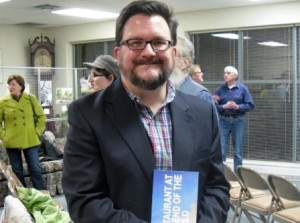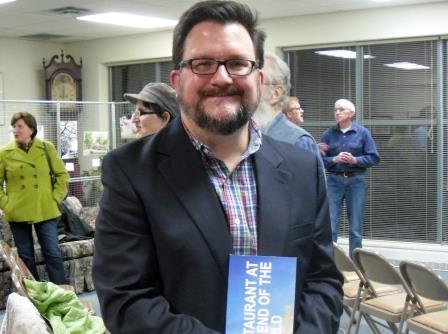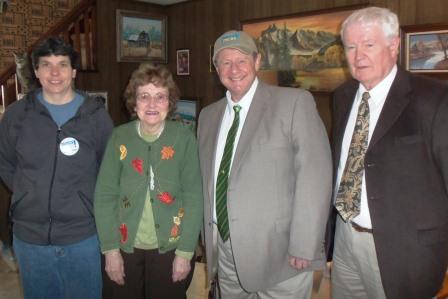
CLEARFIELD – The third program in the American Association of University Women: Books-Sandwiched-In series was held March 19 at the Joseph & Elizabeth Shaw Public Library.
Kenneth Womack reviewed one of his many published books, The Restaurant at the End of the World. The book chronicles the lives of several employees at the Windows on the World restaurant atop the World Trade Center on Sept. 11, 2001.
AAUW member Gwen Crandell introduced the audience to the presenter, a man she heard speak last fall. Crandell felt Womack would be a great addition to the Books-Sandwiched-In series. Crandell revealed that Womack serves in the role of Penn State Laureate and referred to him a “noted author.”
She described three of his books about the Beatles and made mention of his best-selling book about Sheetz. Crandell also mentioned that Womack is currently writing a book about a lost painting in Altoona. With all of these selections for books reviews, Womack chose to discuss The Restaurant at the End of the World with the audience.
Womack began his presentation with an overview of how he came to write a story about the people of the Windows on the World restaurant who died on 9/11. He stated the book was a “strange” one to write and his explanation for writing it is “defensive.”
The author said that he noticed many narratives that memorialized the first responders on 9/11. While he acknowledged that this is rightfully so, he was always curious about the restaurant. Even before the North Tower fell after being struck by an airplane, he was contemplating the fate of the restaurant and its employees. The Restaurant at the End of the World is Womack’s memorialization of the people of the restaurant who perished on 9/11.
The presentation included a slideshow of photos depicting the World Trade Center and the Windows on the World restaurant. Through his description and the accompanying slides, Womack assisted the audience in visualizing the grandeur of the establishment. He informed the audience that the towers of the World Trade Center were 209 feet across, and the Windows on the World restaurant was located in the North Tower on the 106th and 107th floors at the time of its demise.
According to the author, the story of the restaurant is fascinating. As construction of the World Trade Center had begun, a restaurateur named Joe Baum decided early on that he wanted to put an eatery inside one of the towers. Often times these types of establishments are “touristy and expensive.” Additionally, the food is not always of the best quality, as people are paying for the view. Baum, however, hired the best chefs for his restaurant.
According to Womack’s presentation, Baum also played a part in the design of the restaurant. The man who designed the World Trade Centers, Minoru Yamasaki, was known for constructing tall buildings even though he had a great fear of heights. Yamasaki was hesitant to put a restaurant in one of the top floors of the North Tower. As the outside of the tower was made up of a trident design, Baum convinced Yamasaki to have the tridents widen at the top in order to make the windows in the restaurant bigger and the view nicer.
The author continued by stating that the Windows on the World opened in 1976, three years after the World Trade Center towers were finished. It quickly was described as the great new dining experience in the city. On the whole, the restaurant was open for 25 years, except for a period of time when it had to be rebuilt following the World Trade Center bombing in 1993. When the restaurant reopened in 1996 after the rebuild, the 106th floor was added to its structure; it was utilized for banquets and reservations. The Windows on the World was the most profitable restaurant in the United States.
For Womack, the book began as he wondered what happened to the restaurant and its people. He started research on the Internet but was unable to find lists of people associated with the restaurant on that day. He knew that there was a conference to be held that morning, and that it was a large event. Womack wondered why there was such an omission of the restaurant workers in publications. It turns out, he said, that many were immigrants and undocumented workers. For most of the people associated with the restaurant, their “story died with them.”
The presenter knew those who were above the 89th floor of the North Tower did not survive, and he wanted to know more about those associated with the Windows on the World. With his research, Womack was able to have additional names memorialized on the fountain associated with the victims of 9/11.
With his research, Womack wanted to tell the stories of these people. As the author put it, “Well, I’m in now. Something is going to happen with this.” He compared his feelings to that of a quote from William Faulkner’s As I Lay Dying: “We go on, with a motion so soporific, so dreamlike as to be uninferant of progress, as though time and not space were decreasing between us and it.” Womack wanted to shrink the time and space between the reader and the victims from Windows on the World. He said he intended to bring them back to life for a moment in the book, and it was his goal to make the story real.
Womack’s presentation continued as he shared a few selections regarding characters from the book. Included in the book are a number of unique characters, including Doris, the club manager; and Jesus Cabezas, one of the oldest people on staff and a man who had beaten several times.
The author asked the audience to close their eyes while he read a selection from the book about a special character named Christine Olender. She was the assistant general manager and considered to be a hero on 9/11. She had worked her way up the ladder at the restaurant to a second in command position. As a person in charge of operations, she was on staff during the busy conference that was held on the banquet floor. Olender made several 9-1-1 calls that day while she helped people find safe pockets of air. She was both commanding and strong in the face of great peril.
Womack also discussed the role of fate in several of the characters’ lives. For example, a waitress named Jan was working that day because she was substituting for another staffer. Chef Michael Lomonaco survived the attacks because he had an appointment on the bottom floor of the North Tower to get new glasses necessary for reading recipes. There was a pastry chef named Heather, who had recently taken a new position in another city and had agreed to work on Sept. 11, 2001 as a favor to Lomonaco on the busy conference day. Additionally, an elevator was out of service on that day and some of the Windows on the World staff were below the 89th floor directing people which way to get to the banquet and restaurant floors. These employees survived the 9/11 attacks because of their location away from the restaurant.
As the book draws to a close, Womack stated that he did not want the characters to die in the North Tower. Olender has the final moment in the book. The assistant general manager who has been putting out fires and dealing with situation after situation all morning states that “tomorrow we’ll wake up and do it again” and there is “always something larger out there.” Womack says the characters hear a loud noise and prepare for the next situation with which they must face.
The presentation concluded with a question-and-answer session with the author. Womack answered a number of inquiries from the audience, including some related to his research. He stated that he had not eaten at the Windows on the World restaurant and compared it to the age old statement of “there is always next time,” which does not always happen.
He reinforced that it was his strict goal of memorializing characters in a positive way, and in order to do so, a great deal of time was spent reading and researching. Additionally, an enormous amount of time was spent situating characters in the right spot because he never wanted to dispute the factual details of the event.
The final event in the AAUW: Books-Sandwiched-In 2014 series will be held Wednesday. Local resident Peg Barton will discuss the novel Mr. Churchill’s Secretary: a Maggie Hope Mystery by Susan Elia MacNeal. The book features the story of a Maggie Hope, and is set in the World War II era. As the book description indicates, Maggie’s access to War Rooms exposes her to the conspiracies of a threatening group determined to change the course of history at any cost. Maggie finds herself involved in a web of spies, murder and intrigue, and when she unravels a mystery that points toward her own family’s hidden secrets, she will discover that her quick wits are all that stand between an assassin’s murderous plan and Churchill himself.
Reservations for the AAUW: Books-Sandwiched-In 2014 series may be placed by calling Shaw Public Library at 814-765-3271 during regular business hours. Shaw Public Library is open Mondays, Wednesdays, and Saturdays from 10 a.m. until 5 p.m., Tuesdays and Thursdays from 10 a.m. until 9 p.m., and Fridays from 12 p.m. until 5 p.m. Additional information may also be found on Shaw Public Library’s Web site at http://www.clearfield.org/shaw.




